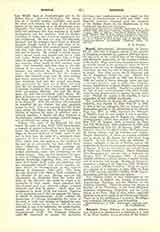

Bogota (BOGOTENSIS), Archdiocese of SANTA FE DE.—The city of Bogota, capital of the republic of Colombia, is situated on a plateau 8700 feet above the sea level, at the western base of the Guadalupe and Monserrat mountains, in the eastern cordillera of the Andes. High mountains surround this plateau on all sides except to the southwest, where the River Funcha cuts its way to Magdalena, forming, a few miles from the city, the falls of Tequendana 475 feet in height. Two other rivers, the S. Francisco and the S. Augustino, divide the city. Bogota was settled by the Spaniards in 1538 and became, in 1598, the capital of Nueva Grenada, which was then a viceregal province, and in 1819, when Colombia became independent of Spain, Bogota was made the capital of the new republic. Bogota is a quaint city, its lack of easy communication with other foreign cities having perpetuated its ancient Spanish character. Though the capital of the republic, it has a population of only 100,000 inhabitants.
The Archdiocese of Bogota, the primatial see of Colombia, was created by Pope Pius IV in 1564. At first it had six suffragans, but, on account of the tremendous growth of the population of the diocese, Pope Leo XIII, in 1902, separated the Bishopric of Medellin from it, and erected it into a province. The actual suffragan sees of Bogota are: Antioquia (Antioquiensis), which was erected a bishopric by Pius VII, August 31, 1804, reerected by Pope Leo XII, January 19, 1829, suppressed in 1868, and reestablished by Pius IX, January 29, 1873. This bishopric contains 211,000 Catholics, 69 Protestants, 75 secular priests, and 80 churches and chapels. Ibague (Ibaguensis), of which no accurate statistics can be given, as the diocese has only lately been created. It was formerly, with the bishopric of Garzon, suffragan to the see of Tolima, and at the extinction of this see was assigned to the Metropolitan of Bogota. It has for its territory the two provinces of North and Central Colombia. Nueva Pamplona (Neo-Pampilonensis), erected into a bishopric by Gregory XVI, September 25, 1835. It contains 250,000 Catholics, 8 secular priests, 7 regular priests, and 46 churches and chapels. Socorro (de Succursu), erected as a bishopric by Pope Leo XIII, March 20, 1895, contains 230,000 Catholics. Tunja (Tunquen sis), erected as a bishopric in July, 1880, by Pope Leo XIII, contains 350,000 Catholics, 10,000 pagans, 53 parishes, and 159 churches and chapels.
The religious orders of men represented in the Archdiocese of Bogota are: Jesuits, Franciscans, Augustinians, Salesians, and the Brothers of the Christian Doctrine. Those for women are: Sisters of Charity, of the Visitation, of the Good Shepherd Salesians, Dominicans, Carmelites, and the Little Sisters of the Poor. Most of these orders, especially those for men, have charge of the schools and colleges. There are in the archdiocese 1 seminary, 30 colleges and academies, 150 schools, and 14 hospitals.
M. DE MOREIRA

